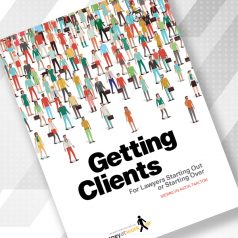Last week’s NY Legal Tech Meetup, “Scaling Small Law: The Force Multipliers of Tech, Process and Innovation,” was a look into ways small firms are winning clients and cases previously out of reach — thanks to technology, smart processes and a willingness to innovate. I enjoyed being part of an awesome panel put together by host Christian Lang, founder of the NY Legal Tech Meetup. My fellow panelists were Phil Rosenthal of Fastcase; Clio’s Joshua Lenon; Kelly Street of AttorneySync; and Matt Blaine of Davison, Eastman, Muñoz, Lederman & Paone.
NY Legal Tech Meetup’s purpose is to build a community around the legal tech ecosystem in New York. This event, held at NYU Law School, was unique because it was the first time the group turned its attention to small law. Here are 10 takeaways.
1. Get Clear
Panelists challenged attorneys to figure out what “being a lawyer” means. What types of cases do you want to take? What types of clients do you want to serve? Do you want to spend most of your time on transactions or in the courtroom? Until you get clear on what being a lawyer means to you, all the tech tools in the world will do nothing to help.
2. Build Systems and Processes for Admin Work
Joshua Lenon, Lawyer-in-Residence at Clio, cited the 2018 Clio Legal Trends report, which found that lawyers bill only an average of 2.4 hours and collect on a mere 1.6 hours per eight-hour day. If you are striving to increase revenue, you need to figure out the best systems and processes to handle administrative tasks. This will help free up your time to focus on billable work.
3. The Sky’s the Limit
If a solo or small firm wants to go after clients who would traditionally turn to Biglaw for services, they can — with the right expertise and the right technology. Wearing my LawClerk hat, I spoke about attorneys who have landed big cases and used flexible staffing services offering freelance lawyers to get the bodies they needed to plow through discovery or handle urgent research projects. The sky really is the limit for small firms that are motivated to go after “whales,” if they implement technology intelligently along the way.
4. Hiring to Scale Up
Once you have clarity on how you want to spend your time, you can figure out a plan to delegate the rest. Delegating nonbillable tasks will free up your time so you can focus on being a lawyer. One of the most common things I hear from attorneys is that they wish they had hired sooner. The first hire for a solo practitioner or small firm may be a virtual receptionist, paralegal or freelance lawyer. Technology provides flexible ways to get help without driving up your overhead.
5. Marketing Trends
Kelly Street, Marketing Director at AttorneySync, said she’s seeing a lot of lawyers build business through Facebook Live and Instagram stories. Video is a powerful way to convey testimonials. Social media sites where you can get reviews can define who you are in the marketplace and validate the good work you say you are doing. Street also advises maximizing your profile on Google My Business, making sure your website is mobile-responsive, and building content on your website and social media that targets the types of clients you want to work with.
6. Customer Service
Street emphasized that customer service is the interwoven thread that binds legal services with good business practices for a successful law practice. Good customer service leads to good reviews, which generates new clients and increases revenue. You can use technology to provide better client service and build relationships. You can also use “old-school” tools like mailing handwritten notes.
7. More Data, Less Guessing
Legal tech tools improve the practice of law by leveraging data. This leads to less guessing and more certainty when making business decisions. There are many KPIs that you can use to evaluate your business performance: billable hours, dollars collected, number of potential clients in your pipeline, net promoter score and how often existing clients refer new clients to you.
8. Meet Clients’ Needs
Matt Blaine of Davison, Eastman, Muñoz, Lederman & Paone shared a story of a client coming to him years ago and asking why there wasn’t a secure way to send a document to the firm. This sparked the firm to research and implement better technology to securely communicate with clients. When clients have issues, pay attention — then change your practices and procedures to meet their needs.
9. Business Mindset
An entrepreneurial spirit is essential to growing solo, small and midsize firms. Whether you want to stay a solo forever or you want to grow, you have to treat your firm like a business, which includes taking risks. Don’t overlook resources like books and podcasts aimed at other industries or entrepreneurs in general. They can be tremendous resources for lawyers in growth mode.
10. Advantages Over Biglaw
There are inherent advantages that small firms have over big law firms. They are more open to alternative fee structures like flat fees, minimum fees and blended rates. They can give clients more attention and access. Phil Rosenthal, President and co-founder of Fastcase, noted that clients working with small firms often have the managing partner’s cellphone number. Small firms are also more nimble. When something isn’t working, they can quickly change course, whether it is a shift in case strategy or business practices.
Bummed that you missed the meetup? Don’t fret — you can check out a replay of the event here.
Illustration ©iStockPhoto.com
Subscribe to Attorney at Work
Get really good ideas every day for your law practice: Subscribe to the Daily Dispatch (it’s free). Follow us on Twitter @attnyatwork.
 GETTING CLIENTS
GETTING CLIENTS
For Lawyers Starting Out and Starting Over
The most difficult challenge you face as a lawyer is figuring out how to get clients. In “Getting Clients,” Merrilyn Astin Tarlton walks you through what you need to be doing — and when you need to be doing it — to become the lawyer you have always wanted to be.
“[O]ne of the smartest, sharpest, wisest books on legal business development you will ever read. Every page contains great ideas, proven strategies, and sage advice for lawyers who want to build thriving practices and are ready to start right now.” — Jordan Furlong

























